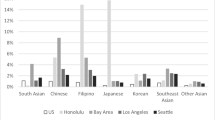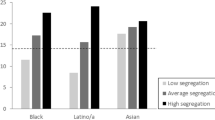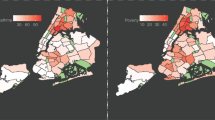Abstract
A great deal of evidence suggests that African-Americans in more racially segregated communities are at a higher risk for a variety of health problems. Scholars have argued that these health inequalities might be explained by racial differences in exposure to air toxins. However, there are a number of ways to measure segregation, each representing different pathways of exposure. There has yet to be a systematic evaluation of how exposure to air toxins varies by these different measures, making it difficult to begin to theorize about the causal story linking segregation, pollution and health. This paper addresses this gap by examining how the health risk from industrial toxins varies by the 19 most commonly used segregation measures. Results show that, with the exception of two segregation measures, living in metro areas with relatively higher segregation levels, is associated with significantly greater health risk from industrial air toxins for all racial groups. Moreover, African-Americans in more segregated metro areas typically experience an added risk of exposure compared to non-Hispanic whites.
Similar content being viewed by others
References
Acevedo-Garcia, D., Lochner, K. A., Osypuk, T. L., & Subramanian, S. V. (2003). Future directions in residential segregation and health research: A multilevel approach. American Journal of Public Health, 93(2), 215–221.
Acevedo-Garcia, D., & Osypuk, T. (2008). Invited commentary: Residential segregation and health—the complexity of modeling separate social contexts. American Journal of Epidemiology, 168(11), 1255–1258.
Ard, Kerry. (2015). Trends in exposure to industrial air toxins for different racial and socioeconomic groups: A spatial and temporal examination of environmental inequality in the U.S. from 1995 to 2004. Social Science Research, 53, 375–390.
Bartik, T. J. (2005). Development incentives. Growth and change, 36(2), 139–166.
Bell, J. F., Zimmerman, F. J., Almgren, G. R., Mayer, J. D., & Huebner, C. E. (2006). Birth outcomes among urban African-American women: A multilevel analysis of the role of racial residential segregation. Social Science and Medicine, 63, 3030–3045.
Blake-Hedges, L., Engler, R., & Lee, R. E. (2007). EPA’s risk-screening environmental indicators (RSEI) methodology RSEI Version 2.1.5. Washington, DC.
Boyce, J., Zwickl, K., & Ash, M. (2014). Three measures of environmental inequality. Institute for New Economic Thinking Working Group on the Political Economy of Distribution Working Paper No. 4.
Britton, M. L., & Shin, H. (2013). Metropolitan residential segregation and very preterm birth among African American and Mexican-origin women. Social Science and Medicine, 98, 37–45.
Brodkin, K. (1998). How Jews became white folks and what that says about race in America. New Brunswick: Rutgers University Press.
Bureau of Labor Statistics. (2015). American Time Use Survey-2014 Results. Retrieved from: http://www.bls.gov/news.release/pdf/atus.pdf.
Collins, C., & Williams, D. (1999). Segregation and mortality: The deadly effects of racism. Sociological Forum, 14(3), 495–523.
Cutter, S. L., Hodgson, M. E., & Dow, K. (2001). Subsidized inequities: The spatial patterning of environmental risks and federally assisted housing. Urban Geography, 22(1), 29–53.
Dawkins, C. (2013). The spatial pattern of low income housing tax credit properties: Implications for fair housing and poverty deconcentration policies. Journal of the American Planning Association, 79(3), 222–234.
Downey, L. (2005). The unintended significance of race: Racial inequality in Detroit. Social Forces, 83(3), 971–1007.
Downey, L. (2007). US metropolitan-area variation in environmental inequality outcomes. Urban Studies, 44(5), 953–977.
Downey, L., Dubois, S., Hawkins, B., & Walker, M. (2008). Environmental inequality in metropolitan America. Organization & Environment, 21(3), 270–294.
Ellis, M., Wright, R., & Parks, V. (2004). Work together, live apart? Geographies of racial and ethnic segregation at home and at work. Annals of Association of American Geographers, 94(3), 620–637.
Evans, G. W., & Kantrowitz, E. (2002). Socioeconomic status and health: The potential role of environmental risk exposure. Annual Review of Public Health, 23, 303–331.
Farley, R., Danziger, S., & Holzer, H. J. (2002). Detroit divided. New York, NY: Russell Sage Foundation.
Gee, G. C., & Ford, C. L. (2011). Structural racism and health inequities: Old issues, new directions. Du Bois Review, 8(1), 115–132.
Gee, G. C., & Payne-Sturges, D. C. (2004). Environmental health disparities: A framework integrating psychosocial and environmental concepts. Environmental Health Perspectives, 112(17), 1645–1653.
Gerrard, M. (1994). Fear and loathing in the siting of hazardous and radioactive waste Facilities- A comprehensive approach to a misperceived crisis. Tulane Law Review, 68, 1137–1146.
Grossman, J. (1991). Black labor is the best labor: Southern White reactions to the great migration. In A. Harrison (Ed.), Black exodus: The great migration from the American South (pp. 51–71). Jackson, MS: University Press of Mississippi.
Hamilton, J. T. (1995). Testing for environmental racism: Prejudice, profits, political power? Journal of Policy Analysis and Management, 14(1), 107–132.
Hayanga, A. J., Zeliadt, S. B., & Backhus, L. M. (2013). Residential segregation and lung cancer mortality in the United States. JAMA Surgery, 148(1), 37–42.
Hird, John A., & Reese, Michael. (1998). The distribution of environmental quality: An empirical analysis. Social Science Quarterly, 79(4), 693–716.
Inagami, S., Cohen, D. A., & Finch, B. K. (2007). Non-residential neighborhood exposures suppress neighborhood effects on self-rated health. Social Science & Medicine, 65, 1779–1791.
Jones, M. R., Diez Roux, A. V., Hajat, A., Kershaw, K. N., Neill, M. S. O., & Guallar, E. (2014). Race/ethnicity, residential segregation, and exposure to ambient air pollution: The multi-ethnic study of atherosclerosis (MESA). American Journal of Public Health, 104(11), 2130–2137.
Kershaw, K. N., Diez Roux, A. V., Burgard, S. A., Lisabeth, L. D., Mujahid, M. S., & Schulz, A. J. (2011). Metropolitan-level racial residential segregation and black-white disparities in hypertension. American Journal of Epidemiology, 174(5), 537–545.
King, K. E. (2014). Chicago residents’ perceptions of air quality: objective pollution, the built environment, and neighborhood stigma theory. Population and Environment, 36(2), 1–21.
Kramer, M. R., Cooper, H. L., Drews-Botsch, C. D., Waller, L., & Hogue, C. R. (2010). Do measures matter? Comparing surface-density-derived and census-tract-derived measures of racial residential segregation. International Journal of Health Geographics, 9(29).
Kramer, M. R., & Hogue, C. R. (2009). Is segregation bad for your health? Epidemiologic Reviews, 31, 178–194.
Kwan, M. P. (2012). The uncertain geographic context problem. Annals of the Association of American Geographers, 102, 958–968.
Kwan, M. (2013). Beyond space (as we knew it): Toward temporally integrated geographies of segregation, health and accessibility. Annuals of the Association of American Geographers, 103(5), 1078–1086.
LaVeist, T. A. (1993). Segregation, poverty, and empowerment: Health consequences for African Americans. The Milbank Quarterly, 71(1), 41–64.
Lee, S., Mohai, P., & Kweon, B. (2010). Comparing TRI emission estimates with the national air toxics assessment and air quality monitoring data. In 2010 National training conference on the toxics release inventory and environmental conditions in communities. Washington, DC.
Lee, B. A., Reardon, S. F., Firebaugh, G., Farrell, C. R., Matthews, S. A., & O’Sullivan, D. (2008). Beyond the census tract: Patterns and determinants of racial segregation at multiple geographic scales. American Sociological Review, 73, 766–791.
Lopez, R. (2002). Segregation and black/white differences in exposure to air toxics in 1990. Environmental Health Perspectives, 110(Suppl), 289–295.
Maantay, J. (2001). Zoning, equity, and public health. American Journal of Public Health, 91(7), 1033–1041.
Massey, D. S., & Denton, N. A. (1988). The dimensions of residential segregation. Social Forces, 67(2), 281.
Meijer, M., Röhl, J., Bloomfield, K., & Grittner, U. (2012). Do neighborhoods affect individual mortality? A systematic review and meta-analysis of multilevel studies. Social Science and Medicine, 74, 1204–1212.
Morello-Frosch, R., & Jesdale, B. M. (2006). Separate and unequal: Residential segregation and estimated cancer risks associated with ambient air toxics in U.S. metropolitan areas. Environmental Health Perspectives, 114(3), 386–393.
Oliver, Eric. (2001). Democracy in Suburbia. Princeton, NJ: Princeton University Press.
Pendall, R., Puentes, R., & Martin, J. (2006). From traditional to reformed: A review of the land use regulations in the nation’s 50 largest metropolitan areas. The Brookings Institute, Research Brief.
Quillian, L. (2003). The decline of male employment in low-income black neighborhoods, 1950–1990. Social Science Research, 32(2), 220–250.
Reardon, S. F., & O’Sullivan, D. (2004). Measures of spatial segregation. Sociological Methodology, 34(1), 121–162.
Saha, R., & Mohai, P. (2005). Historical context and hazardous waste facility siting: Understanding temporal patterns in Michigan. Social Problems, 52(4), 618–648.
Shihadeh, E., & Flynn, N. (1996). Segregation and crime: The effects of black social isolation on the rates of black urban violence. Social Forces, 74(4), 1325–1352.
Stretesky, P., & Hogan, M. (1998). Environmental justice: An analysis of superfund sites in florida. Social Problems, 45(2), 268–287.
Subramanian, S. V., Acevedo-Garcia, D., & Osypuk, T. L. (2005). Racial residential segregation and geographic heterogeneity in black/white disparity in poor self-rated health in the US: A multilevel statistical analysis. Social Science and Medicine, 60, 1667–1679.
Taylor, D. (2014). Toxic communities: Environmental racism, industrial pollution, and residential mobility. New York, NY: New York University Press.
U.S. Census Bureau. (2000). Summary file 1 (SF 1)-100-percent data. Prepared by Social Explorer. Retrieved Feb 2015.
U.S. Census Bureau. (2011). Housing patterns. Retrieved from: www.census.gov/hhes/www/housing/housing_patterns/excel_M/PMSA.html.
U.S. Energy Information Administration. (2015). Form EIA-860 detailed data. Retrieved from: http://www.eia.gov/electricity/data/eia860/.
Venkatesh, S. (2000). American project. The rise and fall of a modern ghetto. Cambridge, MA: Harvard University Press.
Wang, D., Li, F., & Chai, Y. (2012). Activity spaces and sociospatial segregation in Beijing. Urban Geography, 33(2), 256–277.
Weber, A. (1909/1929). Uber den standort der industrien. Translated 1929 as Alfred Weber’s theory of location of industries. (C. J. Friedrich, Trans.). Chicago: University of Chicago Press.
Williams, D. R., & Collins, C. (1995). US Socioeconomic and Racial Differences in Health: Patterns and Explanations. American Review of Sociology, 21(1995), 349–386.
Wilson, W. J. (1987). The truly disadvantaged: The inner city, the underclass, and public policy. Chicago: University of Chicago Press.
Wilson, W. J. (1996). When work disappears: The world of the new urban poor. New York: Alfred A. Knopf.
Wong, D. W. S., & Shaw, S.-L. (2011). Measuring segregation: An activity space approach. Journal of Geographical Systems, 13(2), 127–145.
Yi, S. S., Ruff, R. R., Jung, M., & Waddell, E. N. (2014). Racial/ethnic residential segregation, neighborhood poverty and urinary biomarkers of diet in New York City adults. Social Science and Medicine, 122, 122–129.
Acknowledgments
The author would like to thank Ilya Bolkhovsky, Steve Naber, and the anonymous reviewers for their constructive comments and suggestions.
Author information
Authors and Affiliations
Corresponding author
Rights and permissions
About this article
Cite this article
Ard, K. By all measures: an examination of the relationship between segregation and health risk from air pollution. Popul Environ 38, 1–20 (2016). https://doi.org/10.1007/s11111-015-0251-6
Published:
Issue Date:
DOI: https://doi.org/10.1007/s11111-015-0251-6




